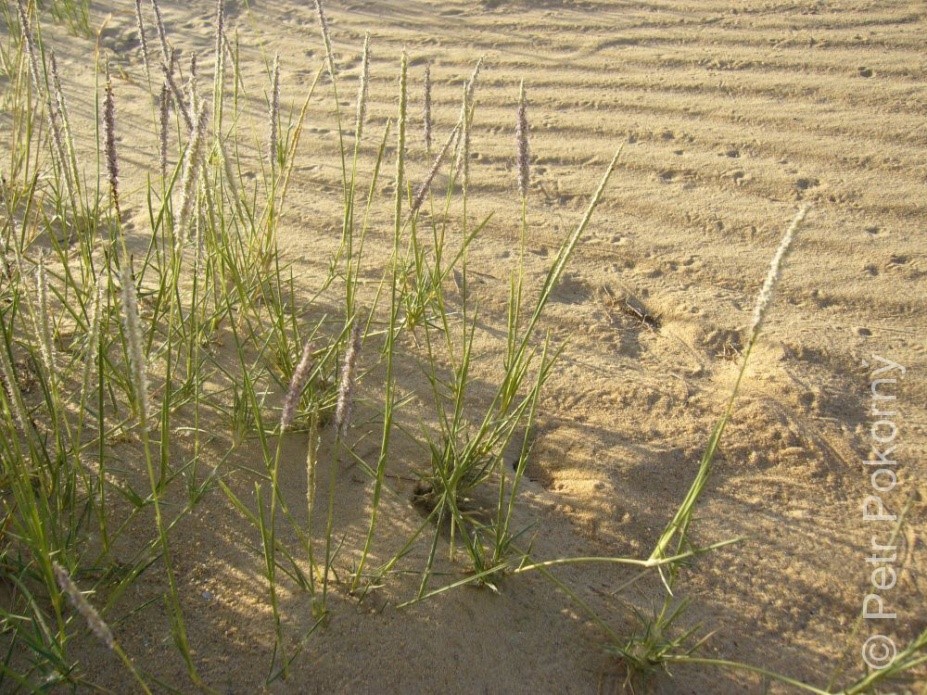
Sporobolus spicatus / أبو ركبه
Agrostis involuta Poir. Agrostis spicata Vahl Agrostis virginica Forssk. Crypsis myosurus Nees ex Steud. Heleochloa myosurus (Steud.) T. Durand & Schinz Sporobolus faucicola Peter Vilfa involuta (Poir.) P. Beauv. Vilfa spicata (Vahl) P. Beauv
Sbat, Mabooz, Al Barsta, Sbat Jabali, Samah, sal, Salah, Sakham, Najeel Shwoki, Abu Rakb, Abu Rakbah, Sbat Rakb, Rukebah
Salt grass
Dhafrem, defera, Sakham, Rashad, Half Barri, Abu Rakbah
Poaceae
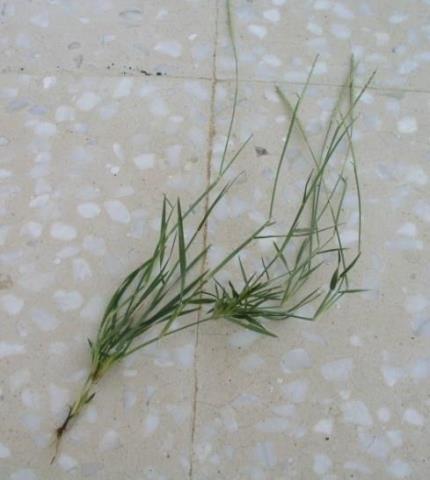
Aerial parts
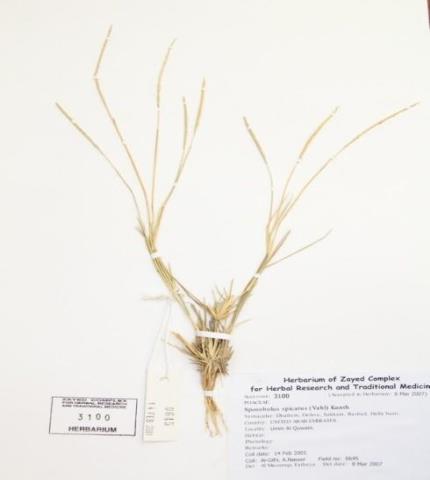
Herbarium specimen
Ethnobotanical Characteristics
Description
Perennial to 40 cm with creeping stolons, often forming extensive mat-like clumps, variable in appearance. Much-branched from base and rooting nodes; base often white and rest of foliage blue-green. Leaves narrow, rough on the upper surface, younger ones flat, older ones rolled and narrowly pointed. Flowering stems very thin, erect, with 4-6 narrowly-cylindrical equal spikes to 6cm, pointed and very pale, often powdery.
Habitat and Distribution
Perhaps commonest weed in towns, plantations and lowland farms, found in Abu Dhabi old sewage farm; it can tolerate high salinity. In dry months it forms stolon growth is minimal (Western, 1989). It is local but sometimes abundant grass found from sea level up to 2000 m on hard clay and alluvial plain that are periodically or permanently moist with salty water (Western, 1989; Wood, 1997)
Pharmacognosy and Phytochemistry
Plant parts of interest
Dried stem and branches
General appearance
The stem and branches are slender, glabrous, yellow or yellowish green in colour. The stem gives rise to erect branches which are brittle and easily broken into hollow parts but some branches do not break easily.
Microscopic characteristics
A surface view of the epidermal layer of the branch exhibits the character of the Gramineae (Poaceae) family, namely the long and short cells together with the stomata that have dumb-bell shapes; the long cells have characteristic sinuous walls. A transverse section through the stem shows its cylindrical outline with broad outer ridges and also its mono-cotyledonous character of scattered closed vascular bundles. The epidermis consists of a layer of nearly rounded small cells. As the circumference of the branch consist of about 18 broad arches, each arch represents a unit of repeated zones. Studying the layers from the periphery inwards, each epidermal layer of an arch is underlain by about two layers of small anticlinal light yellow cells followed by a layer of comparatively larger oval dark yellow cells that surround groups of lightly lignified fibres with thick walls and narrow lumens. These are followed by the moderately lignified vascular tissues with their wide xylem pitted tracheids. The pith occupies a wide central zone, and it consists of rounded parenchyma cells.
Parts studied
Dried stem and branches
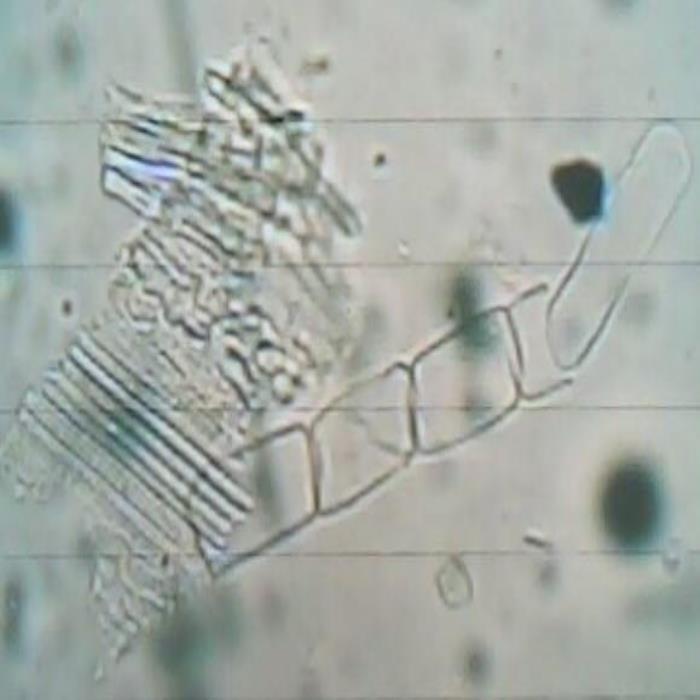
A) Surface of stem

B) TS of stem
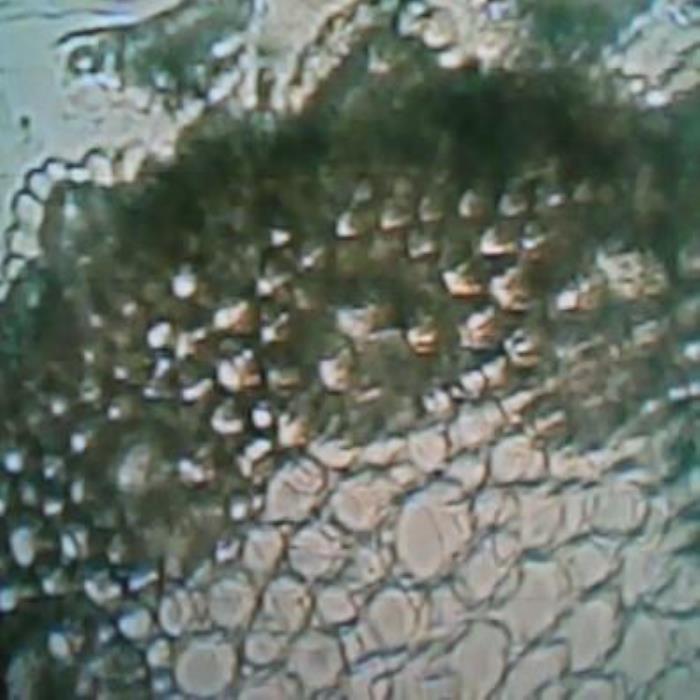
C) Detailed TS of stem
- A. A fragment of the surface of the stem from below showing the characteristic long and short cells of the epidermis with stomata having the dumb-bell shape (to the left) together with isolated groups of wide xylem pitted tracheids (to the right).
- B. TS of the stem showing its different layers without the epidermal layer: light yellow cortical cells, groups of lightly lignified fibres, moderately lignified vascular tissues (dark areas) and central pith.
- C. Detailed TS of the stem near the periphery showing two of the broad arches, the outer epidermal layer of each is composed of nearly rounded small cells followed by yellow cortical cells. The pith consists of rounded parenchyma cells.
Chemical constituents
Betain; N, N-Dimethyl glycine; 2-Nitro acetamide; Isobornyl acetate; ascorbic acid 2,6-dihexadecanoate; beta sitosterol; Isobornyl thiocyanoacetate; D-sucrose.
The following chemical studies have been carried out on the plant Sporobolus spicatus Kunth (Quality Control methods, 1998; Evans, 1996; ZCHRTM unpublished work)
Physicochemical constants
Loss of weight in drying at 105°C : 9.50
Absolute alcohol solubility : 1.60
Water solubility : 13.20
Successive extractives (%)
Petroleum ether (60-80) °C : 1.30
Chloroform : 1.60
Absolute alcohol : 8.20
Ash values (%)
Total ash : 12.17
Water soluble ash : 3.50
Acid insoluble ash (10% HCl) : 4.17
pH values (aqueous solution)
pH of 1% solution : 6.364-6.459
pH of 10% solution : 5.814-5.820
Elemental analyses
Ash values (British Herbal Pharmacopeia)
Assay and identification of element (AOAC- International)
|
Apparatus |
(AA-6800 Shimadzu) |
||||
|
Element |
Std. conc. µg/ml |
Sample conc. mg/ml |
sample absorbance |
Actual conc.mg/ml |
Actual conc. (%) |
|
Cr |
1, 2, 4 |
10 |
0.000 |
<0.0001 |
<0.00001 |
|
Zn |
0.25, 0.5, 1 |
10 |
0.2421 |
0.0727 |
0.00727 |
|
Cu |
1, 2, 4 |
10 |
0.0122 |
0.0146 |
0.00146 |
|
Fe |
1, 2, 4 |
0.909 |
0.1516 |
0.27948 |
0.027948 |
|
K |
1, 2, 4 |
0.909 |
0.3562 |
2.71687 |
0.271689 |
|
Pb |
1, 2, 4 |
10 |
0.0000 |
<0.0001 |
<0.00001 |
|
Cd |
0.125,0.25,0.5 |
10 |
0.0000 |
<0.000125 |
<0.000012 |
|
Ca |
5, 10, 20 |
0.0826 |
0.0415 |
13.28701 |
1.3287 |
|
Mg |
0.25, 0.5, 1 |
0.0826 |
0.2838 |
2.92215 |
0.292215 |
|
Na |
1,2,4 |
0.909 |
0.2823 |
6.4583 |
0.64583 |
| 1ppm conc. = 1µg/ml; Actual conc. (%) =Actual conc.(ppm)x0.0001 [1ppm=0.0001%] | |||||
UV Spectral studies
|
Ultraviolet Spectrum (USP reference) |
||||
|
Apparatus |
Beckman DU 520 general purpose UV/VIS spectrophotometer. |
|||
|
Sample conc. (mg / ml) |
Solvent |
λ max (nm) |
λ min (nm) |
Abs. ( λ max - λ min) |
|
0.996 |
Intestinal Fluid simulated without pancreatic pH=7.5 0.1 |
204 273.5 |
260 |
1.362 0.321-0.310 |
|
0.838 |
Gastric Fluid simulated without pepsin pH =1.2 0.1 |
203.5 272 |
259.5 |
0.981 0.218- 0.208 |
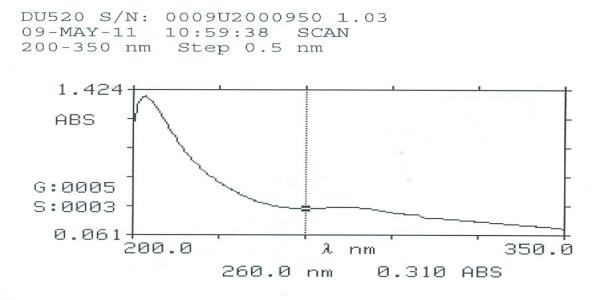
Intestinal Fluid simulated without pancreatic
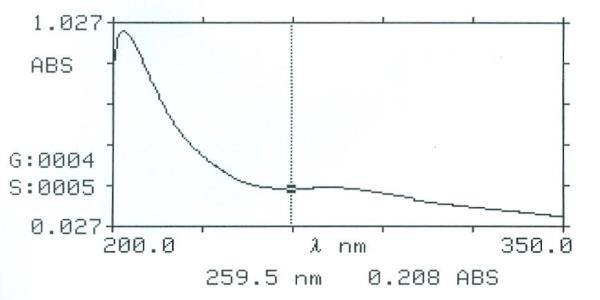
Gastric Fluid simulated without pepsin
Chromatographical Studies
Thin layer chromatography (TLC): Wagner and Bladt, 1996

A

B

C

D
TLC fingerprint of Petroleum ether 60-80°C (track 1) and MeOH extract (track 2)
|
Mobile phase Fig. |
A&B |
: |
Toluene, ethyl formate, formic acid (5:4:1) |
|
|
C |
: |
Ethyl acetate, methanol, water (100:13.5:10) |
|
|
D |
: |
Toluene, ethyl acetate (93:7) |
|
Detection |
A |
: |
UV 254nm |
|
Derivatization |
B, C&D |
: |
Vanillin- Sulphuric acid –vis. |
Pharmacological and toxicological Studies
Literature and reported information of the plant: The important pharmacological and toxicological activities of the plant Sporobolus sp. reported in various scientific journals presented below:
(Martinelli 2007) reported for the first time, a description of sucrose localization in dehydrating leaf tissues of a "resurrection" plant. Our studies also showed that, during dehydration stress, sucrose accumulates in all viable tissues; these results are in agreement with the previously proposed theories about its function as a cellular protective.
The effect of feeding Sporobolus and Rhodes hay on the relative absorption phenylbutazone (4 g) was examined in six camels. It was concluded that the phasic absorption of phenylbutazone in serum was a particular feature of hay feeding in camels, and the Sporobolus hay can be fed to camels without any effect on the rate and extent of phenylbutazone absorption compared to Rhodes grass hay (Abdel Hadi, 2005).
The following pharmacological and safety evaluation studies were carried out (Derelanko 2002; Han, 2003) on the Sporobolus spicatus plant aqueous extract:
|
ACTIVITY |
RESULTS |
|||
|
|
Strong |
Moderate |
Mild |
Negative |
|
Analgesic (Writhing) |
|
|
|
√ |
|
Analgesic (Hot plate) |
|
|
|
√ |
|
Antidepressant (TST) |
√ |
|
|
|
|
Anti-inflammatory (Rat paw edema) |
|
|
|
√ |
|
Anticonvulsant activity |
|
|
|
√ |
|
Antithrombotic activity (PT + FIB) |
|
|
|
√ |
|
Effect on Guinea pig tracheal chain |
|
|
|
√ |
|
Effect on rat detrusor muscle |
|
√ |
|
|
|
Effect on Guinea pig ileum |
|
|
|
√ |
|
Effect on rat fundus |
|
|
√ |
|
|
Effect on rat atria (HR) ↓ |
|
√ |
|
|
|
Biochemical studies (ALT) ↓ |
√ |
|
|
|
|
Hematological studies (RBC,HGB,HCT &MCV) ↑ |
|
|
√ |
|
|
Acute toxicity |
|
|
|
√ |
|
Locomotor activity test |
|
|
√ |
|
|
Motor co-ordination (Rota rod) test |
|
|
√ |
|
|
Rectal temperature |
|
|
|
√ |
|
Body weight |
|
|
|
√ |
|
Mortality |
|
|
|
√ |
|
LD50= |
> 10G/KG |
|||
Summary of the results
The extract caused moderate contraction on the detrusor muscle indicating medium anti-urolithic effect. The heart rate was decreased indicating (negative chronotropic effect). The Aqueous extract of the plant decreased Alanine transaminase significantly as compared to the control. The extract increased the animal’s activity and did not exhibit any toxic effects at the dose tested (ZCHRTM-Unpublished results).

Anti-urolithic effect on detrusor muscle
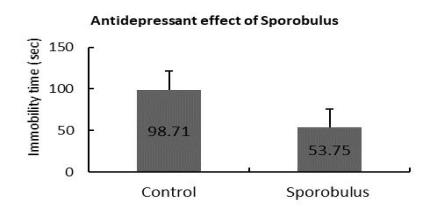
Antidepressant effect in mice

Hematological effects
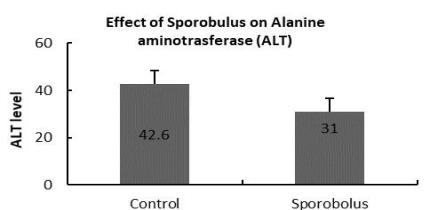
Effect on ALT

Effect on locomotor activity
Antimicrobial activity
The aqueous extract of the whole plant was tested against Mycobacterium smegmatis, Candida tropicalis, different strains of Staphylococcus aureus (Including ATCC 257) as well as strains of Methicillin Resistant Staphylococcus aureus, strains of E. coli (Including ATCC UN 109), different strains of ESBL-producing K. pneumonia, E. coli, Pseudomonas aeruginosa, but showed no inhibition of growth.
References
- Abdel Hadi AA, Wasfi IA, Elghazali M, Almahrami AM, Barezaiq IM, Alkatheeri NA, Alhadrami GA. Comparison of the effect of Sporobolus virginicus and Rhodes (Chloris gayana) hay diets on the absorption pattern of phenylbutazone in the camel (Camelus dromedarius). Vet J. 2005, 169:91-6.
- J.R.I.Wood. A handbook of the Yemen flora, Royal Botanic Garden, Kew, p.373, 1997.
- Jonbloed, M. V., Feulner, G. R., Boer, B. & Western, A. R. (2003). The comprehensive Guide to the Wild Flowers of the United Arab Emirates, Erwda, Abu Dhabi, U.A.E.
- Martinelli T.In situ localization of glucose and sucrose in dehydrating leaves of Sporobolus stapfianus. J Plant Physiol. Vol. 165, 2007, 6: 580-587
- Western, A. R. (1986). The Flora of United Arab Emirates. An introduction. -Al Ain.
- Western, A. R. (1989). The Flora of United Arab Emirates. An introduction. Publications of the U.A.E. University.
